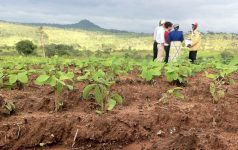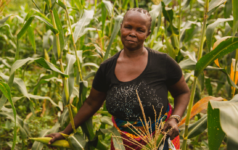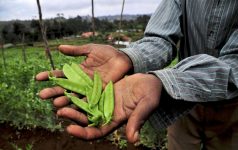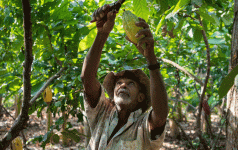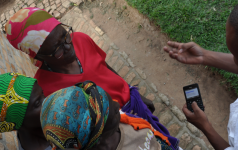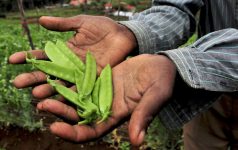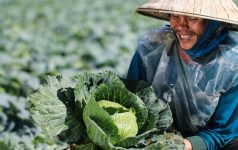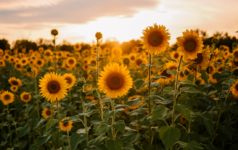Dalberg uses cookies and related technologies to improve the way the site functions. A cookie is a text file that is stored on your device. We use these text files for functionality such as to analyze our traffic or to personalize content. You can easily control how we use cookies on your device by adjusting the settings below, and you may also change those settings at any time by visiting our privacy policy page.
Smart solar irrigation helps farmers increase yields, resilience and income in the face of the dual challenges of locust infestation and Covid-19

Case Study: David Mutuga, Eldoret
David is a 43 year old, full-time farmer from Eldoret, located in Kenya’s Rift Valley region, with four children. He owns 3 acres, which he has been farming for 20 years. Since purchasing a pay-as-you-go solar water pump, he has seen a big improvement in his yield.
“Before I received this solar panel, I was harvesting 4,000 heads of cabbage;
now I harvest 20,000”
The pump now also allows him to harvest crop, when prices are high.
“Rainy season is when everyone is planting; however by then my products will be almost ready and I can sell them at a higher price”
With locusts returning in the midst of Covid-19 pandemic, Kenya is facing two formidable threats to its food security. The World Bank estimates Kenya’s agricultural losses to be $1.5 billion from the locust invasion alone. Even before these twin crises, resilience was critical – the chance of drought is 40% each year. Increased availability and implementation of proven agricultural technology that can help irrigate fields and protect crops could go a long way in boosting productivity and increasing overall resilience for the sector.
Today, just 3% of Kenya’s arable land is irrigated, with the remaining areas relying on increasingly unpredictable rainfall. Smallholder farmers produce the majority (78%) of Kenya’s food, but existing efforts towards irrigation focus on large-scale demonstration farms, led by the public sector. The government of Kenya aims to reach 1.2 million irrigated acres by 2022, but the most recent data suggests that less than half that figure will be achieved.
Solar water pumps as a solution
The use of solar water pumps by individual farmers can double agricultural yield, and in some instances, outputs are quadrupled. With reliable irrigation, farmers can make the switch to higher-value crops, such as French beans and peas, which produce 30-50ksh/kilo (compared to 20ksh/kilo for maize).
The year-round water that irrigation provides means an additional planting season can be created, allowing harvests to be timed for when market prices are highest. Because the pumps are powered by the sun, money is saved on fuel. Farmers also control how much or how little the pump is used, paying for its operation through monthly payments enabled by their increased income. More predictable income also supports the farmers’ ability to be resilient during times of drought or unexpected expenditure.
Dalberg Advisors and Mercy Corps AgriFin (AFA) came together to conduct a study in early 2020 on ways to accelerate the adoption of solar water pumps and the potential impact that pump usage could have on Kenya’s agriculture sector. Affordability, financing, limited awareness, and unreliable water access all stand as obstacles today, but they can be overcome: Dalberg and Mercy Corps AFA found that if significant interventions are developed and launched to address these four constraints, 1.7 million farmers could increase their daily income by an average of 177% in the next ten years, allowing Kenya to achieve its ‘Big Four’ food security targets.
Priming the solar water pump market for growth
Acting on these four areas will help solar water pumps achieve their potential in Kenya:
- Establishing financial incentives to make the pumps affordable: A smart subsidy is needed, with a contribution also made by farmers themselves, to allow more Kenyans to access solar water pump technology. “Smart”, because if the farmers don’t pay their monthly portion, the pump can be disabled remotely.
- Providing finance to allow for monthly payments: At present, the pumps are financed by the distribution companies themselves, a model that will limit the industry from reaching scale. Banks and microfinance Institutions, who already know the ins and outs of the rural lending market, must come on board to increase the supply of pumps and reduce the cost of finance.
- A wide-reaching awareness program: Gaps in knowledge and understanding about the benefits of solar water pumps holds farmers back from adoption. The sub-scale nature of the current industry means there is a first-mover disadvantage, as any marketing investment benefits all parties, not just the company that is promoting its products. The government’s own extension worker teams could play a key role in publicizing the ways that digitally enabled, water efficient, long lasting pumps can support smallholder farmers – a use of time and resource that would benefit all stakeholders.
- Improving water access: Many parts of the country struggle with water supply, yet aquifers contain usable water. A county-led initiative to increase water access for farmers, specifically for irrigation, is required.
For Kenya to build resilience for the current and future agriculture crises, investments must focus on immediate boosts to agricultural productivity, as well as long-term investments that can be sustained well into the future. Aided by key incentives and interventions, farmers can leverage a solar water pump to take on the challenge of increasing their output in an accessible, sustainable way.
The 11 June 2020 Kenya National Budget brought a major encouragement to the sector: the announcement of 3.5 billion Kenya Shillings ($35 million USD) for “expanded community household irrigation”. This can be a positive step forward to increasing smallholder farmer yield, resilience and incomes.
The Irrigation Policy Paper was launched on Thursday 25th June 2020 with an online panel including Kenya’s Principal Secretary State Department for Crop Development & Agricultural Research Hamadi Iddi Boga, Vinay Vutukuru (Head of Agriculture Portfolio for World Bank Kenya), Samir Ibrahim (CEO of SunCulture), Lauren Hendricks (CEO of Equity Foundation) and Martha Haile (Africa VP for WeFarm). The Webinar PowerPoint, recording, and full Irrigation Policy paper are available on the Mercy Corps Agrifin website.
To discuss the report, or any aspects of Agricultural Digitisation, contact Naoko.Koyama@Dalberg.com or Michael.Tweed@dalberg.com.


